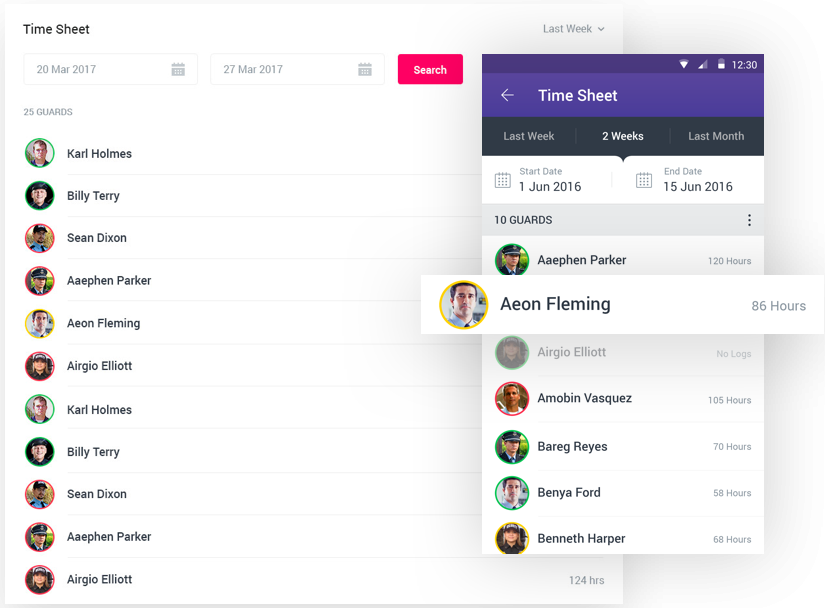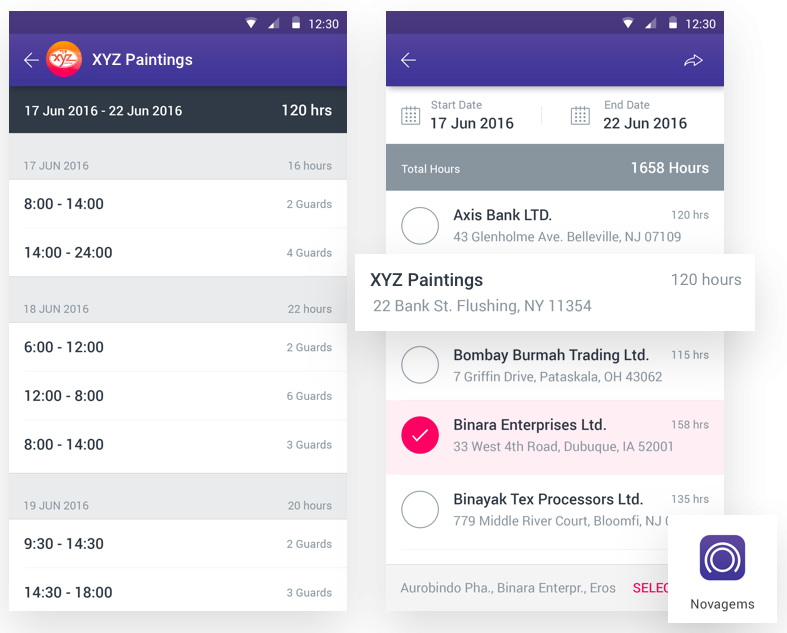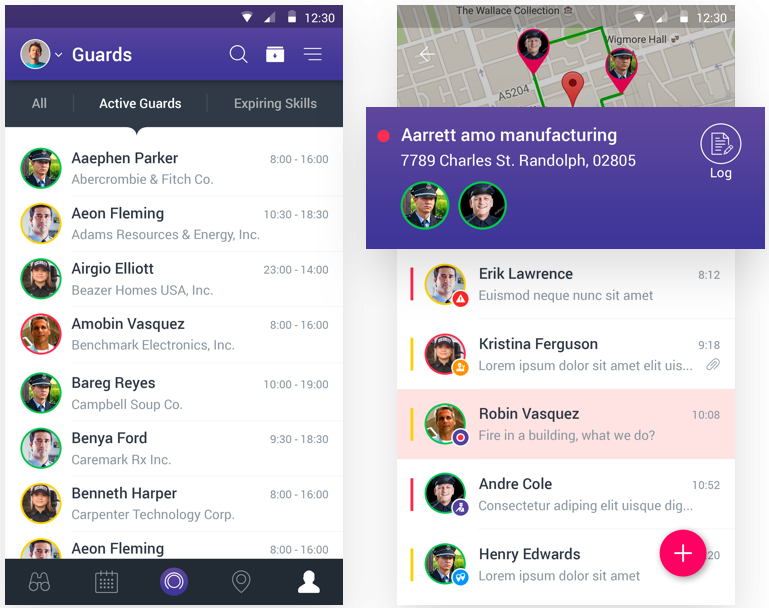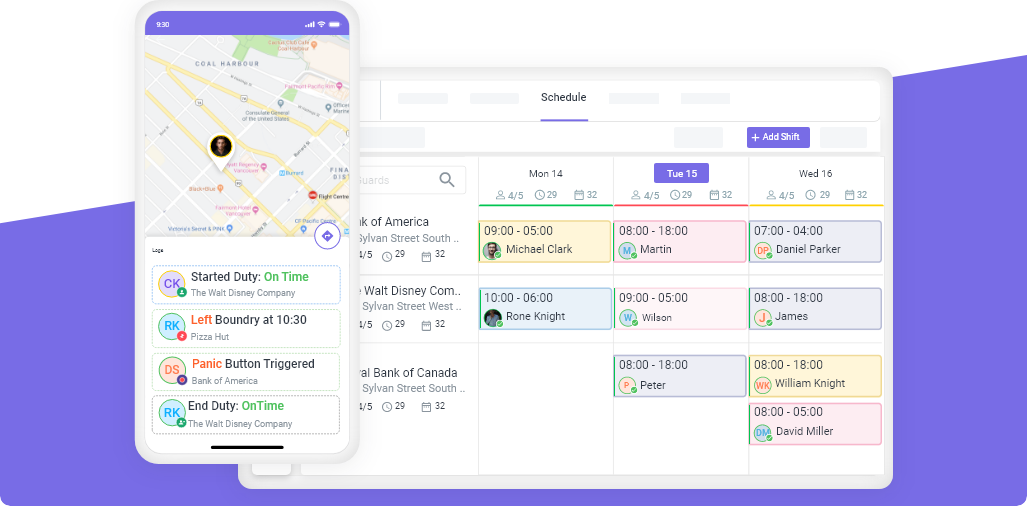Back Office Operations Management System | Back Office Management Software - Novagems
Thu, Jul 22, 2021
Read in 6 minutes

Optimize your back office operations with an efficient management system. Simplify tasks, boost productivity, and ensure seamless workflow management for enhanced efficiency and effectiveness in your organization’s administrative processes. In layman terms a software that manages the back office operations is what you need.
Guard time sheet

- The office management software shows attendance, Site tours and physical presence over multiple sites in Guard timesheet
- Generate the automated pdf at no extra cost and available anytime and anywhere
- Ensures accuracy and minute-by-minute timekeeping
Site invoice

- Generates the accurate invoices for any site during the user specified time interval
- Client-friendly PDF generation at backend over a single click
Reliable back office management software for multiple site management. Advanced control on invoicing with the best back-office management system.
Attendance

- Automated attendance
- Notifies as the guard starts or end the duty and when the guard leaves his area
Automated back office management software offering high accuracy and smooth functioning.
What Functions Reside in Back-Office Operations?
Back-office management software encompasses a range of functions that support the administrative and operational aspects of a business. Some common functions that typically reside in back-office operations include:
Data Entry and Management: Processing and managing data, including customer information, financial records, inventory data, and other relevant data sets. Back office management system will make this task seem like a walk in the park.
Accounting and Finance: Handling financial transactions, invoicing, accounts payable and receivable, payroll processing, financial reporting, budgeting, and financial analysis.
Human Resources (HR): Managing employee records, benefits administration, onboarding, training and development, performance management, employee relations, and compliance with employment laws and regulations.
Procurement and Supply Chain: Managing procurement processes, vendor relationships, inventory management, order fulfillment, logistics coordination, and ensuring smooth supply chain operations.
IT Infrastructure and Support: Managing IT systems, network infrastructure, software applications, troubleshooting technical issues, and providing technical support to employees.
Compliance and Regulatory Compliance: Ensuring adherence to industry regulations, compliance with legal requirements, managing licenses and permits, data privacy and security, and risk management.
Document Management: Organizing and maintaining company documents, records, contracts, and compliance documentation.
Administrative Support: Providing administrative assistance such as scheduling, calendar management, travel arrangements, meeting coordination, and general office management tasks.
Reporting and Analytics: Generating and analyzing reports, key performance indicators (KPIs), and metrics to monitor and assess business performance and make informed decisions.
Quality Assurance and Process Improvement: Implementing quality control measures, conducting audits, identifying process inefficiencies, and driving continuous improvement initiatives to enhance operational effectiveness.
It’s important to note that the specific functions within back-office operations can vary depending on the nature of the business, industry, and organizational structure. Back office system software is the one that will help you optimize the task and bring everyone from different departments together.
The Benefits of a Back Office Operations Management System:
A back office operations management system is a comprehensive software solution designed to streamline and automate various administrative tasks. Here are some key benefits it can offer:
Enhanced Efficiency:
With a centralized platform, your team can easily collaborate, access information, and complete tasks in a more efficient manner. Automated workflows and standardized processes reduce manual errors and accelerate productivity.
Improved Data Accuracy:
Data integrity is crucial for back office operations. A management system ensures accurate data entry, storage, and retrieval, minimizing the risk of errors and enabling better decision-making.
Cost Savings:
By automating repetitive tasks and optimizing resource allocation, a management system can reduce operational costs and increase profitability. It eliminates the need for excessive paperwork, physical storage, and manual data handling.
Compliance and Security:
Back office operations often involve sensitive data, financial records, and compliance requirements. A management system ensures data security, facilitates regulatory compliance, and provides audit trails for accountability.
Scalability and Growth:
As your business expands, managing increasing volumes of data and processes can become challenging. A scalable operations management system can accommodate growth and adapt to evolving business needs seamlessly.
What Are the Top Challenges Back Office Operations Management Systems?
While a back office operations management system can bring numerous benefits to an organization, it is important to be aware of the potential challenges that may arise during its implementation and usage. Here are some of the top challenges associated with back office operations management systems:
- Integration Complexity:
Integrating a new management system with existing software and processes can be complex and challenging. Compatibility issues, data migration, and ensuring seamless data flow between systems can pose obstacles during implementation. It requires careful planning, coordination, and possibly the involvement of IT professionals to ensure a smooth integration.
- Resistance to Change:
Implementing a new system often faces resistance from employees who are accustomed to existing processes and tools. Some employees may feel apprehensive about learning new software or fear that their roles might be impacted. Change management strategies, clear communication, and comprehensive training programs can help address these concerns and facilitate a smooth transition.
- User Adoption and Training:
The successful adoption of a back office operations management system depends on how effectively users understand and utilize its features. Insufficient or inadequate training can hinder user adoption and result in underutilization of the system’s capabilities. It is crucial to provide comprehensive training programs and ongoing support to ensure that employees are comfortable and proficient in using the system.
- Data Security and Compliance:
Back office operations often involve handling sensitive data, including financial records, employee information, and customer data. Ensuring data security and compliance with privacy regulations (such as GDPR or HIPAA) is a significant challenge. Organizations need to implement robust security measures, access controls, encryption, and regular system audits to protect sensitive information and maintain compliance.
- Scalability and Customization:
As businesses grow and evolve, their back office operations may become more complex and require additional functionalities. Scalability and customization options offered by the management system become crucial. Organizations must choose a system that can adapt to their changing needs, accommodate increased data volumes, and allow for the customization of workflows and processes.
- User Interface and Experience:
A user-friendly interface and intuitive user experience are essential for the successful adoption of any software system. If the back office operations management system has a complex or intuitive interface, users may find it difficult to navigate and use efficiently. It is important to select a system with a user-friendly design, logical workflows, and clear instructions to ensure user satisfaction and maximize productivity.
- Vendor Support and Maintenance:
Choosing a reliable vendor that offers adequate technical support and regular system updates is critical. Organizations need to assess the vendor’s track record, reputation, and the level of support they provide. Quick response times, proactive troubleshooting, and regular software updates are vital to address any issues or bugs that may arise and ensure the system’s smooth functioning.
Parting Words
A robust back office operations management system is a game-changer for businesses aiming to optimize their administrative tasks, enhance productivity, and boost profitability. By streamlining processes, improving data accuracy, and reducing costs, such a system empowers organizations to focus on their core responsibilities.
Novagems is the best office management system software that ensures accuracy and efficiency in back office management operations.
Get a Free Trial
Sign up For Newsletter
Latest Blog Posts
Get Started
Start being productive & grow your business
with Novagems




